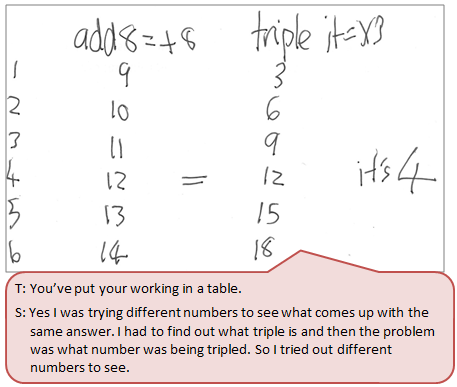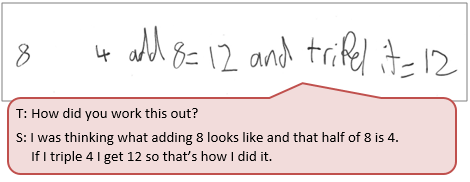The purpose of this activity is to engage students in using their knowledge of number operations to find an unknown.
This activity assumes the students have experience in the following areas:
- Knowing basic facts for addition and subtraction.
- Applying simple multiplication to equal sets problems.
- Solving change unknown problems using inverse operations.
The problem is sufficiently open ended to allow the students freedom of choice in their approach. It may be scaffolded with guidance that leads to a solution, and/or the students might be given the opportunity to solve the problem independently.
The example responses at the end of the resource give an indication of the kind of response to expect from students who approach the problem in particular ways.

I’m thinking of a number.
I get the same answer if I add 8 to my number, or if I don’t add 8 but instead I triple my number.
What number am I thinking of?
The following prompts illustrate how this activity can be structured around the phases of the Mathematics Investigation Cycle.
Make sense
Introduce the problem. Allow students time to read it and discuss in pairs or small groups.
- Do I understand what I need to do? (Find the mystery number.)
- How will I know when I have the right number?
- Do I have some idea what the number might be? How?
- What will an answer look like? (The answer will be the mystery number but it must satisfy the clues.)
Plan approach
Discuss ideas about how to solve the problem. Emphasise that, in the planning phase, you want students to say how they would solve the problem, not to actually solve it.
- What strategies will be useful to solve a problem like this? (Trial and error, making a table, drawing a diagram, being systematic, and using symbols, are all potentially useful.)
- What numbers and operations will I use? How might I record those operations as equations?
- What tools (digital or physical) could help my investigation?
Take action
Allow students time to work through their strategy and find a solution to the problem.
- Is my strategy working or do I need to change what I am doing?
- Have a tried some numbers to see what works?
- How am I keeping track of the numbers I have tried?
- Is the working clear so someone else can follow it?
- How can I express my solution using diagrams, numbers, and words?
- Have I used the most efficient way to solve the problem? What other ways can I find?
Convince yourself and others
Allow students time to check their answers and then either have them pair share with other groups or ask for volunteers to share their solution with the class.
- Is my working clear for someone else to follow?
- How would I convince someone else I am correct?
- Is my solution expressed in a mathematical way?
- What would the answer be if I changed the clues?
- Can I make a similar problem to this one?
- Can I come up with a general strategy that works on these kinds of problems?
Examples of work
Work sample 1
The student uses a systematic trial strategy, trying the counting numbers to find the unknown number. They organise the results in a table and look for patterns.
Click on the image to enlarge it. Click again to close.
Work sample 2
The student conjectures that 4 is the missing number since twice the number equals 8. They check their conjecture by calculating 4 + 8 and 3 x 4 and getting the same result.

